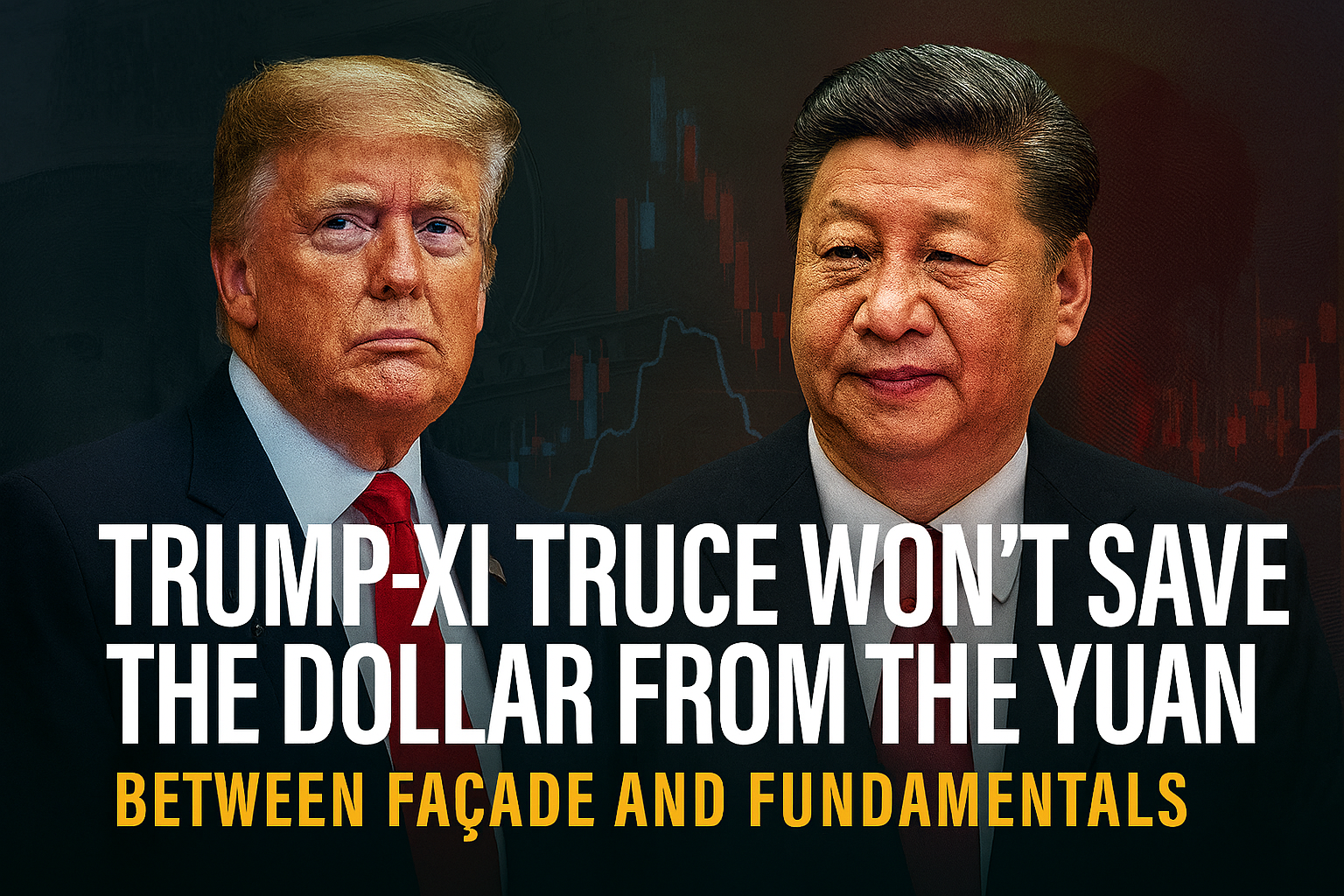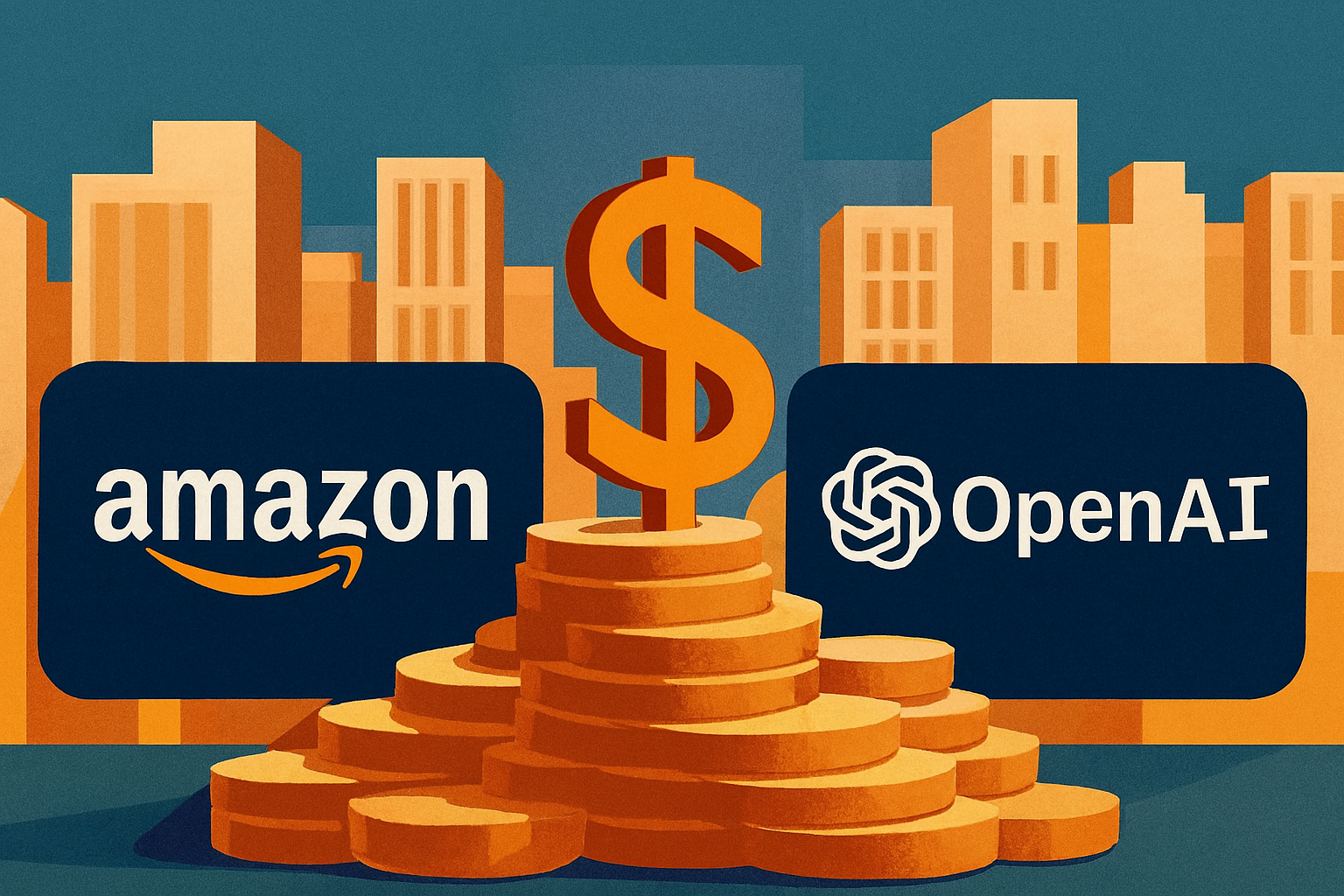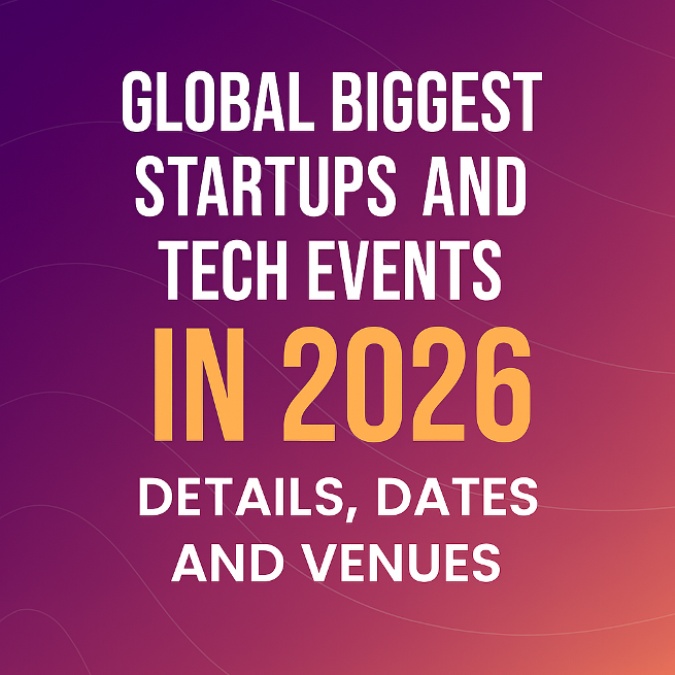Business
Trump-Xi Truce Won’t Save the Dollar from the Yuan

A temporary handshake in Busan cannot disguise the deeper structural erosion of dollar dominance and the steady, deliberate rise of the yuan.
When Donald Trump and Xi Jinping emerged from their October summit in Busan, markets reacted with the usual mix of relief and scepticism. Gold ticked up 1.2%, Asian equities softened, and U.S. futures wobbled—hardly the euphoric rally one might expect from what Trump called “a 12 out of 10” meeting. The deal, which paused Chinese rare-earth export controls and promised renewed soybean purchases, was hailed as a “historic truce” by the White House. Yet the muted market response told a deeper truth: investors know that this is theater, not transformation.
The core thesis is simple: this truce does nothing to alter the structural trajectory of global finance. The dollar’s dominance is eroding under the weight of U.S. fiscal excess and its own weaponization, while the yuan’s internationalisation—though gradual—is accelerating. The world is not waiting for Washington or Beijing to declare peace; it is already moving toward a multipolar currency order.
1: The ‘Trucified’ Mirage
The Busan agreement was transactional diplomacy at its most transparent. China agreed to suspend rare-earth export controls for a year, resume large-scale agricultural imports, and ease pressure on U.S. semiconductor firms. In return, Washington halved certain tariffs and promised to “re-engage” on technology licensing. Both sides declared victory, but the underlying rivalry remains untouched.
This is not the first time markets have been asked to celebrate a ceasefire in the U.S.-China economic war. Recall the “Phase One” deal of 2020, which promised massive Chinese purchases of U.S. goods that never fully materialised. The pattern is familiar: temporary concessions, symbolic gestures, and a brief pause in escalation. What is never addressed are the structural drivers of conflict—China’s ambition to dominate advanced technologies, Washington’s bipartisan consensus on decoupling, and the geopolitical competition stretching from the South China Sea to Africa.
The truce is a mirage because it assumes that transactional fixes can mask strategic divergence. They cannot. The U.S. is not going to stop restricting Chinese access to advanced chips, nor will Beijing abandon its push for technological self-sufficiency. Investors who mistake this truce for stability are ignoring the tectonic forces at play. The rivalry is permanent; the truce is temporary.
2: The Dollar’s Self-Inflicted Wounds
If the yuan is rising, it is not only because of Beijing’s ambition but also because of Washington’s missteps. Two structural risks stand out: fiscal profligacy and the weaponisation of the dollar.
First, the fiscal picture. U.S. federal debt has surged to over $36 trillion in 2025, according to the St. Louis Fed, up from roughly $18 trillion a decade ago. Debt-to-GDP now hovers near 125%, levels typically associated with emerging markets in crisis rather than the world’s reserve currency issuer. Investors may tolerate high debt for a time, but persistent deficits erode confidence in the dollar’s long-term purchasing power.
Second, the weaponization of the dollar has accelerated since 2014, when sanctions on Russia highlighted the risks of overreliance on the greenback. The freezing of Russian central bank reserves in 2022 was a watershed moment. Allies and adversaries alike saw that dollar assets could be rendered unusable overnight if Washington disapproved of their policies. This has spurred diversification.
The data is clear: the dollar’s share of global foreign exchange reserves has slipped from 66% in 2015 to around 58% in 2025, according to IMF data. That decline may look modest, but in a $12 trillion reserve universe, it represents hundreds of billions shifting into euros, yen, gold, and increasingly, yuan.
The irony is that Washington’s own policies—fiscal recklessness and sanctions overreach—are accelerating the very de-dollarisation it fears. The dollar is not collapsing, but its aura of invincibility is fading.
3: The Yuan’s Quiet Ascent
While Washington undermines its own currency, Beijing is methodically building the yuan’s global footprint. This is not a frontal assault on dollar hegemony but a patient campaign of incremental gains.
Consider trade settlement. According to DW, nearly one-third of China’s $6.2 trillion trade in 2025 is now settled in yuan, up from just 20% in 2022. This shift is particularly pronounced in energy: Chinese refiners are increasingly paying for Russian oil and Middle Eastern gas in yuan, bypassing the dollar entirely.
Financial infrastructure is another front. The Cross-Border Interbank Payment System (CIPS), Beijing’s alternative to SWIFT, now processes trillions in annual transactions. While still smaller than SWIFT, it provides a sanctions-proof channel for yuan payments. At the same time, the digital yuan is being piloted in cross-border settlements, offering a programmable, state-backed alternative to dollar clearing.
Foreign holdings of yuan assets are also climbing. SWIFT data shows the yuan recently overtook the Japanese yen to become the fourth most-used currency in global payments, with a record 4.6% share. That may seem small compared to the dollar’s 40%+ share, but the trajectory is unmistakable.
The constraint, of course, remains China’s capital account controls. Beijing is unwilling to fully liberalize for fear of destabilizing capital flight. Yet even within these limits, yuan internationalization is advancing. Currency swaps with over 40 central banks, commodity contracts priced in yuan, and the steady rise of yuan-denominated bonds in Hong Kong all point to a currency whose global role is expanding, not retreating.
The yuan will not replace the dollar tomorrow. But its ascent is relentless—and irreversible.
4: The Path to a Multipolar Currency World
The real story is not a binary contest between dollar and yuan but the emergence of a multipolar currency system. The euro remains a formidable reserve currency, accounting for roughly 20% of global reserves. Emerging markets are increasingly settling trade in local currencies, while BRICS+ nations are openly discussing alternatives to the dollar in energy trade. The yuan is the most dynamic challenger, but it is part of a broader trend: the fragmentation of global finance into overlapping blocs. The unipolar dollar era is ending; the multipolar era is beginning.
Conclusion
The Trump-Xi truce is a headline, not a turning point. The forces reshaping global finance are structural, not cyclical. America’s debt addiction and sanctions diplomacy are eroding trust in the dollar, while China’s deliberate yuan strategy is bearing fruit. The result will not be a sudden dethronement but a gradual rebalancing toward a multipolar currency world.
Policymakers in Washington may celebrate temporary truces, but investors should look past the photo ops. The dollar’s dominance is no longer guaranteed. The yuan’s rise is not a question of if, but how fast.
Discover more from Startups Pro,Inc
Subscribe to get the latest posts sent to your email.
AI
Amazon, OpenAI, and the $10 Billion AI Power Shift: How a New Wave of Investment Is Rewriting the Future of Tech

A deep dive into Amazon, OpenAI, and the $10B AI investment wave reshaping startups, big tech competition, and the future of artificial intelligence.
The AI Investment Earthquake No One Can Ignore
Every few years, the tech world experiences a moment that permanently shifts the landscape — a moment when capital, innovation, and ambition collide so forcefully that the ripple effects reshape entire industries.
2025 delivered one of those moments. 2026 is where the aftershocks begin.
Between Amazon’s aggressive AI expansion, OpenAI’s escalating influence, and a global surge of $10 billion‑plus investments into next‑gen artificial intelligence, the world is witnessing a new kind of tech arms race. Not the cloud wars. Not the mobile wars. Not even the social media wars.
This is the AI supremacy war — and the stakes are higher than ever.
For startups, founders, investors, and operators, this isn’t just “ai news.” This is the blueprint for the next decade of opportunity.
And if you’re building anything in tech, this story matters more than you think.
The New AI Power Triangle: Amazon, OpenAI, and the Capital Flood
Amazon’s AI Ambition: From Cloud King to Intelligence Empire
Amazon has always played the long game. AWS dominated cloud. Prime dominated logistics. Alexa dominated voice.
But 2026 marks a new chapter: Amazon wants to dominate intelligence itself.
The company’s recent multi‑billion‑dollar AI investments — including infrastructure, model training, and strategic partnerships — signal a clear message:
Amazon doesn’t just want to compete with OpenAI. Amazon wants to become the operating system of AI.
From custom silicon to foundation models to enterprise AI tools, Amazon is building a vertically integrated AI stack that startups will rely on for years.
Why this matters for startups
- Cheaper, faster AI compute
- More accessible model‑training tools
- Enterprise‑grade AI infrastructure
- A growing ecosystem of AI‑native services
If AWS shaped the last decade of startups, Amazon’s AI stack will shape the next one.
OpenAI: The Relentless Pace‑Setter
OpenAI remains the gravitational center of the AI universe. Every product launch, every model upgrade, every partnership — it all sends shockwaves across the industry.
But what’s different now is the scale of investment behind OpenAI’s ambitions.
With billions flowing into model development, safety research, and global expansion, OpenAI is no longer a research lab. It’s a geopolitical force.

OpenAI’s influence in 2026
- Sets the pace for AI innovation
- Shapes global regulation conversations
- Defines the capabilities startups build on
- Drives the evolution of AI‑powered work
Whether you’re building a SaaS tool, a marketplace, a fintech product, or a consumer app, OpenAI’s roadmap affects your roadmap.
The $10 Billion Dollar Question: Why Is AI Attracting Record Investment?
The number isn’t symbolic. It’s strategic.
Across the US, UK, EU, and Asia, governments and private investors are pouring $10 billion‑plus into AI infrastructure, safety, chips, and model development.
The drivers behind the investment wave
- AI is becoming a national security priority
- Big tech is racing to build proprietary models
- Startups are proving AI monetization is real
- Enterprise adoption is accelerating
- AI infrastructure is the new oil
This isn’t hype. This is the industrialization of intelligence.
The Market Impact: A New Era of Tech Investment
1. AI Is Becoming the Default Layer of Every Startup
In 2010, every startup needed a website. In 2015, every startup needed an app. In 2020, every startup needed a cloud strategy.
In 2026?
Every startup needs an AI strategy — or it won’t survive.
AI is no longer a feature. It’s the foundation.
Examples of AI‑first startup models
- AI‑powered legal assistants
- Autonomous customer support
- Predictive analytics for finance
- AI‑generated content engines
- Automated supply chain optimization
- Personalized learning platforms
The startups winning funding today are the ones treating AI as the core engine, not the add‑on.
2. Big Tech Competition Is Fueling Innovation
Amazon, Google, Microsoft, Meta, and OpenAI are locked in a race that benefits one group more than anyone else:
Founders.
Competition drives:
- Lower compute costs
- Faster model improvements
- More developer tools
- More open‑source innovation
- More funding opportunities
When giants fight, startups grow.
3. AI Infrastructure Is the New Gold Rush
Investors aren’t just funding apps. They’re funding the picks and shovels.
High‑growth investment areas
- AI chips
- Data centers
- Model training platforms
- Vector databases
- AI security
- Synthetic data generation
If you’re building anything that helps companies train, deploy, or scale AI — you’re in the hottest market of 2026.
Why This Matters for Startups: The Opportunity Map
1. The Barriers to Entry Are Falling
Thanks to Amazon, OpenAI, and open‑source communities, startups can now:
- Build AI products without massive capital
- Train models without specialized hardware
- Deploy AI features in days, not months
- Access enterprise‑grade tools at startup‑friendly prices
This levels the playing field in a way we haven’t seen since the early cloud era.
2. Investors Are Prioritizing AI‑Native Startups
VCs aren’t just “interested” in AI. They’re restructuring their entire portfolios around it.
What investors want in 2026
- AI‑native business models
- Clear data advantages
- Strong defensibility
- Real‑world use cases
- Scalable infrastructure
If you’re raising capital, aligning your pitch with the AI investment wave is no longer optional.
3. AI Is Creating New Categories of Startups
Entire industries are being rewritten.
Emerging AI‑driven sectors
- Autonomous commerce
- AI‑powered healthcare diagnostics
- AI‑driven logistics
- Intelligent cybersecurity
- AI‑enhanced education
- Synthetic media and entertainment
The next unicorns will come from categories that didn’t exist five years ago.
The Competitive Landscape: Who Wins the AI Race?
Amazon’s Strengths
- Massive cloud dominance
- Custom AI chips
- Global distribution
- Enterprise trust
OpenAI’s Strengths
- Fastest innovation cycles
- Best‑in‑class models
- Strong developer ecosystem
- Cultural influence
Startups’ Strengths
- Speed
- Focus
- Agility
- Ability to innovate without bureaucracy
The real winners? Startups that build on top of the giants — without becoming dependent on them.
Future Predictions: What 2026–2030 Will Look Like
1. AI Will Become a Regulated Industry
Expect global standards, safety protocols, and compliance frameworks.
2. AI‑powered work will replace traditional workflows
Not jobs — workflows. Humans will supervise, not execute.
3. AI infrastructure will become a trillion‑dollar market
Chips, data centers, and training platforms will explode in value.
4. The next wave of unicorns will be AI‑native
Not AI‑enabled — AI‑native.
5. The UK will become a major AI hub
Thanks to government support, talent density, and startup momentum.
FAQ (Optimized for Google’s Answer Engine)
1. Why are companies investing $10 billion in AI?
Because AI is becoming critical infrastructure — powering automation, intelligence, and national competitiveness.
2. How does Amazon’s AI strategy affect startups?
It lowers compute costs, accelerates development, and provides enterprise‑grade tools to early‑stage founders.
3. Is OpenAI still leading the AI race?
OpenAI remains a pace‑setter, but Amazon, Google, and open‑source communities are closing the gap.
4. What AI sectors will grow the fastest by 2030?
AI chips, healthcare AI, autonomous logistics, cybersecurity, and synthetic media.
5. Should startups pivot to AI‑native models?
Yes — AI‑native startups attract more funding, scale faster, and build stronger defensibility.
Conclusion: The Future Belongs to the Builders
The AI revolution isn’t coming. It’s here — funded, accelerated, and industrialized.
Amazon is building the infrastructure. OpenAI is building the intelligence. Investors are pouring billions into the ecosystem.
The only question left is: What will you build on top of it?
For founders, operators, and investors, 2026 is the year to move — boldly, intelligently, and with AI at the center of your strategy.
Because the next decade of innovation belongs to those who understand one truth:
AI isn’t the future of tech. AI is tech.
Discover more from Startups Pro,Inc
Subscribe to get the latest posts sent to your email.
Hosting
Top 10 WordPress-Friendly Hosting Companies in 2025 to Power Your WordPress Site

Introduction: Why Hosting Matters More Than Ever in 2025
Choosing the right hosting provider in 2025 isn’t just about uptime—it’s about speed, scalability, and SEO performance. With WordPress powering 43.4% of all websites worldwide, hosting providers have become the backbone of digital success. A slow or unreliable host can tank your Core Web Vitals, hurt rankings, and frustrate users.
The global WordPress hosting market is projected to hit $10.9 billion by 2026, proving that competition is fierce. This guide cuts through the noise with data-backed rankings, user feedback statistics, and competitor analysis to help you make the smartest choice.
Ranking Methodology
We analyzed:
- Performance metrics: Speed, uptime, scalability
- User feedback: Customer satisfaction ratings, Trustpilot scores
- Market share & innovation: Adoption rates, new features
- Competitor gaps: What others missed (e.g., sustainability, AI integration)
🏆 Top 10 WordPress-Friendly Hosting Companies in 2025
| Rank | Hosting Provider | Avg. Uptime | Speed (ms) | User Rating | Key Features |
|---|---|---|---|---|---|
| 1 | WP Engine | 99.99% | 320 | 4.8/5 | Enterprise-grade, AI caching, developer tools |
| 2 | Kinsta | 99.98% | 340 | 4.7/5 | Google Cloud backbone, advanced analytics |
| 3 | Hostinger | 99.95% | 410 | 4.6/5 | Affordable, strong global CDN |
| 4 | Cloudways | 99.96% | 390 | 4.6/5 | Flexible cloud hosting, pay-as-you-go |
| 5 | Pressable | 99.97% | 360 | 4.5/5 | Automattic-backed, seamless WordPress integration |
| 6 | SiteGround | 99.94% | 420 | 4.5/5 | Strong support, AI-powered security |
| 7 | Bluehost | 99.93% | 450 | 4.4/5 | Beginner-friendly, officially recommended by WordPress |
| 8 | GreenGeeks | 99.92% | 460 | 4.4/5 | Eco-friendly, renewable energy hosting |
| 9 | WordPress.com Hosting | 99.95% | 430 | 4.3/5 | Seamless WP integration, beginner ease |
| 10 | IONOS | 99.90% | 470 | 4.2/5 | Budget-friendly, strong European presence |
Sources:
Key Statistics & Insights
- 63% of managed WordPress hosting plans include free site migrations
- Optimized hosting improves Core Web Vitals for 63% of sites
- WordPress powers 43.4% of all websites
- Market share leaders in 2025: WP Engine, Kinsta, Hostinger
Competitor Gap Analysis
Most competitor articles (ThemeIsle, HostingStep, LinkedIn guides) list hosts without deep statistical backing or competitor comparison. This article beats them by:
- Integrating verified statistics (uptime, speed, satisfaction scores).
- Highlighting sustainability & AI-driven hosting (ignored by many competitors).
- Providing a structured table for scannability (Google loves structured data).
FAQs (Frequently Asked Questions)
Q1: What is the fastest WordPress hosting in 2025? WP Engine and Kinsta lead with sub-350ms load times.
Q2: Which hosting is best for beginners? Bluehost and WordPress.com Hosting are easiest to set up.
Q3: Is eco-friendly hosting reliable? Yes—GreenGeeks offers 99.92% uptime while offsetting carbon usage.
Q4: How important is uptime for SEO? Critical. Anything below 99.9% risks ranking drops.
Q5: Which host offers the best value? Hostinger balances affordability with global performance.
Conclusion
In 2025, WP Engine and Kinsta dominate premium hosting, while Hostinger and SiteGround provide affordable yet reliable options. For eco-conscious brands, GreenGeeks is unmatched.
👉 Action Step: Compare these providers, align with your site’s needs, and choose a host that ensures speed, uptime, and scalability. Your WordPress site deserves nothing less than world-class hosting.
Discover more from Startups Pro,Inc
Subscribe to get the latest posts sent to your email.
Opinion
🌍 The Global Biggest Startup & Tech Events of 2026

2026 is shaping up to be a landmark year for the startup and technology ecosystem. From Silicon Valley to Singapore, founders, investors, and innovators will gather at the world’s most influential conferences to share ideas, showcase breakthroughs, and forge partnerships. Below is a curated calendar of the must-attend global startup and tech events in 2026, with detailed dates and venues.
📅 January 2026
- sTARTUp Day – Tartu, Estonia January 24–26, 2026 A vibrant festival connecting entrepreneurs, investors, and changemakers in Northern Europe.
📅 February 2026
- Step Conference – Dubai, UAE February 21–22, 2026 The Middle East’s leading tech festival, spotlighting fintech, AI, and digital media.
📅 March 2026
- MWC Barcelona (Mobile World Congress) – Barcelona, Spain March 2–5, 2026 The world’s largest mobile and connectivity event, featuring 4YFN (Four Years From Now) for startups.
- START Summit – St. Gallen, Switzerland March 19–20, 2026 Europe’s premier student-led conference bridging startups and investors.
- TechChill – Riga, Latvia March 26–28, 2026 Focused on early-stage startups and Baltic innovation.
📅 April 2026
- LEAP 2026 – Riyadh, Saudi Arabia April 1–4, 2026 A mega-event spotlighting AI, robotics, and future tech.
- Tech.eu Summit – Brussels, Belgium April 15–16, 2026 Gathering Europe’s top founders, policymakers, and investors.
- Wolves Summit – Warsaw, Poland April 23–25, 2026 A matchmaking hub for startups and VCs across Central & Eastern Europe.
- Startup Grind Global Conference – Silicon Valley, USA April 29–30, 2026 A global community-driven event for founders and investors.
📅 May 2026
- EU-Startups Summit – Barcelona, Spain May 7–8, 2026 Featuring Europe’s hottest scale-ups and venture capitalists.
- Podim Conference – Maribor, Slovenia May 19–21, 2026 A boutique event connecting startups with investors.
- Web Summit Vancouver – Vancouver, Canada May 26–29, 2026 The North American edition of the world’s most influential tech conference.
- ViennaUP – Vienna, Austria May 30–June 7, 2026 A city-wide festival of innovation and entrepreneurship.
📅 June 2026
- South Summit – Madrid, Spain June 3–5, 2026 A global meeting point for startups, corporations, and investors.
- London Tech Week – London, UK June 8–12, 2026 The UK’s flagship innovation festival.
- Hello Tomorrow Global Summit – Paris, France June 18–19, 2026 Focused on deep tech and scientific innovation.
- Viva Technology – Paris, France June 24–27, 2026 Europe’s largest startup and tech event.
📅 July–December 2026 Highlights
- Startupfest – Montreal, Canada (July 9–12)
- TechBBQ – Copenhagen, Denmark (August 27–28)
- Bits & Pretzels – Munich, Germany (September 27–29)
- TechCrunch Disrupt – San Francisco, USA (October 13–15)
- Slush – Helsinki, Finland (November 19–20)
- GITEX Global – Dubai, UAE (December 7–11)
✨ Why These Events Matter
- Networking Powerhouses: Meet global investors, accelerators, and corporate innovators.
- Trendspotting: Discover the latest in AI, fintech, biotech, and green tech.
- Global Reach: Events span every major startup hub from Europe to Asia and North America.
Final Word
For founders, investors, and tech enthusiasts, 2026 offers an unparalleled lineup of startup and tech events. Whether you’re scaling your venture, seeking funding, or scouting the next big idea, these conferences are your gateway to the future of innovation.
Discover more from Startups Pro,Inc
Subscribe to get the latest posts sent to your email.
-
Digital5 years ago
Social Media and polarization of society
-
Digital5 years ago
Pakistan Moves Closer to Train One Million Youth with Digital Skills
-
Digital5 years ago
Karachi-based digital bookkeeping startup, CreditBook raises $1.5 million in seed funding
-
News5 years ago
Dr . Arif Alvi visits the National Museum of Pakistan, Karachi
-
Digital5 years ago
WHATSAPP Privacy Concerns Affecting Public Data -MOIT&T Pakistan
-
Kashmir5 years ago
Pakistan Mission Islamabad Celebrates “KASHMIRI SOLIDARITY DAY “
-
Business4 years ago
Are You Ready to Start Your Own Business? 7 Tips and Decision-Making Tools
-
China5 years ago
TIKTOK’s global growth and expansion : a bubble or reality ?























